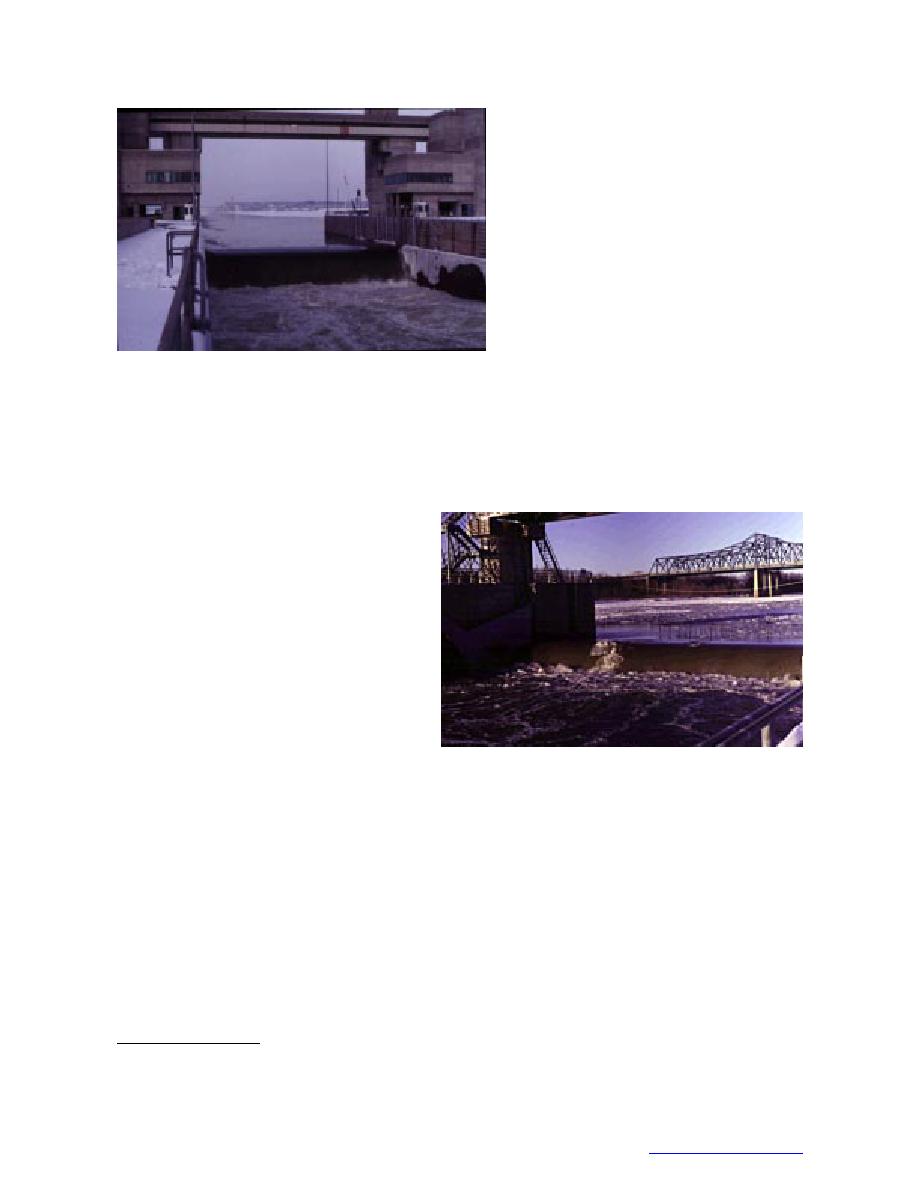
the ice pieces are frozen together, and ice
clearing relies on towboat propeller wash to
break up the ice and move it towards the
gates. Physical model studies at CRREL
found that ice passage at Starved Rock could
be improved by locating an angled submerg-
ible gate adjacent to the lock (Tuthill and
Gooch 1997).
Upstream of Starved Rock on the Illinois
Waterway, at Dresden Island Lock and Dam,
a similar scheme of intermittent gate open-
ings is used to clear the lock approach area
of ice. Ice passage problems at Dresden
Island are less severe than at Starved Rock
because the ice is thinner and less abundant,
Figure 8. Passing ice over the upstream lift gate of the main
owing to upstream thermal inputs.
lock at Melvin Price Lock and Dam on the Mississippi River.
Downstream of Starved Rock, at Peoria,
m to cause a sudden drop in pool level that would
Illinois, a 18-m-wide submergible tainter gate
break the ice free from the dam and shores. This
located alongside the lock has proven extremely
ice-clearing operation depended heavily on assis-
effective at diverting and passing the ice pushed
tance from navigation and it had to happen when
ahead of downbound tows (Fig. 9).
there was sufficient river discharge to compen-
sate for the outflow through the dam.
The ice passage capability of the new Melvin
Price Lock and Dam is greatly simplified and
improved compared to the old structure. Ice is
now passed over the upstream lift gate of the
centrally located main lock, as shown in Fig-
ure 8. In addition to flow over the gate, the
upstream filling valves are partially opened to
help flush the ice through the lock chamber.
The objective is to continuously clear ice from
the navigation channel between lockages with-
out disturbing the adjacent sheet ice. Warming
and rain can still break up the sheet ice cover,
requiring tainter gate openings, in addition to
the lock lift gate, to clear the upstream pool.*
Figure 9. Submergible gate at Peoria Lock and Dam on the
Illinois Waterway.
Illinois Waterway: Starved Rock,
Dresden Island, and Peoria Locks
and Dams, Illinois
Midwinter flow regulation:
At Starved Rock Lock and Dam, brash ice that
Water supply and ice jam formation
accumulates in the lock approach must travel lat-
Release schedules from multipurpose res-
erally 180 m along face of the dam, past power-
ervoirs on western U.S. rivers often balance
house intakes, to reach the nearest two tainter
summertime irrigation and recreational needs
gates. Opening both 18-m-wide gates 1.5 m creates
of upstream water users against the need to pro-
3/s and sufficient sur-
a discharge of about 420 m
vide for downstream navigation depths and
face velocity in the 5-m-deep pool to clear accu-
water supply requirements. This task is most dif-
mulations of loose brash. Discharge at this gate
ficult during periods of extreme drought, when
opening is well above winter average river flow,
low flows may reduce ice conveyance capacity
so the operation must as brief as possible. Often,
and cause freezeup ice jams. As water impounds
upstream of the jams, the resulting flow deficits
downstream may uncover or hinder the operation
* Personal communication with lockmaster Thomas Miller,
of water intakes. The lowermost 1390 km of the
12 January 1999.
13
Go back to contents pg



 Previous Page
Previous Page
